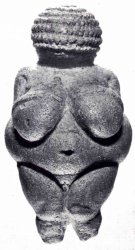|
The History of Pottery
The History of Pottery is believed to have begun in the period 29,000 to 25,000 BC, when the earliest known ceramic (molded of clay and fired) objects were created, including the Venus or Grimaldi figurines. This period is known as the Upper Paleolithic period, sometimes referred to as the "Late Stone Age". During this Upper Paleolithic period in Europe, the Cro-Magnons (early Homo sapiens), began creating many sophisticated stone tools, cave art and artifacts including the Venus figurines. 
The Venus (Grimaldi) Figurine refers to a collection of female human figurines that experts believe were individually owned amulets meant to ensure the safe completion of pregnancy (Randall White 2007). These figurines were believed to gain power with age, and were likely passed down from mother to daughter over a number of generations. So far the earliest Pottery (pots and other utility items) were found in Southern China, in The Yuchanyan Cave. These items are estimated to be 18,000 years old. And there are many more from 10,000 BC in Japan and China. The invention of the Pottery Wheel in Mesopotamia, sometime between 6,000 and 4,000 BC, caused the pottery industry to leap forward. The first kilns, were basically bonfires. After that the pit or trench kilns where used. Heating clay, causes the particles to fuse together. This is called sintering. For formed clay to be called pottery, it must be fired. It depends on the material used,but in general…
The amount of time the clay is heated is called the Soak time. Think about what an accomplishment it must have been back in the day, just to do what they had to, to make a pot. If you use wood or coal for firing, the ash causes the color and texture of the piece to vary. This concept is used in Malaysia, to create Labu Sayung. The Japanese call it Raku, (and all this time I thought that was Spaghetti sauce!!!) Any way to make Raku or Labu sayung, you remove the piece from the Kiln while still red hot and place it in a container, cover it with wood chips or ash, and cover the container. This causes a carbonized effect. Mission Accomplished! And as long as we're talking about the History of Pottery, lets cover the origin of the Piggy Bank? Well you see, the word Pygg refers to a relatively inexpensive orange clay that was once very popular for making pottery in the form of jars, cookware, and other household items. Originally the "Pygg Jar" (at the time pronounced "pug") was used to hold miscellaneous coins in the household. Over time the word "pygg" began to be pronounced "pig" (sometime you'll have to read about the "Great vowel shift" for an etymological lesson on historical changes to pronunciation that took place). After this change the spelling of "pig" was adopted. Next thing you know, the "Pygg Jar" is now being made in the shape of a (you guest it) a Pig. And the Piggy Bank was minted. Somewhere along the line, some one figured out pottery glazes. Glazing decorates the pot, but most importantly, it waterproofs the pot. That’s a pretty handy thing to have if you need to carry a liquid. The glaze thing is pretty complicated, so we devoted an entire page to pottery glazes. So as you can see, the History of Pottery is rich with innovation and function. From materials, to techniques and uses; forming and firing clay has served mankind well for many thousands of years. |



